| Apr-21-06 | | percyblakeney: With this win Eisenberg stopped Pillsbury from winning Monte Carlo 1902 (Maroczy took first place). It was a big tournament with 20 players, apart from the top two among others Janowski, Schlechter, Tarrasch, Chigorin and Marshall. Eisenberg only won one more game, against second to last Reggio. |
|
| Jan-21-07 | | SBC: <percyblakeney>
Thanks for this posting. It encourage me to look a bit into the 1902 Monte Carlo tournament. While there's not much information available, Tim Harding made an excellent presentation in the 1902 edition of his year-by-year series - http://www.chesscafe.com/text/kibit... . It seems that while it's true that Eisenberg's win did effectively keep Pillsbury out of first place, there were other reasons in this strong, but unusual tournament that affected the results. Here is a quote from Harding's article that emphasizes the peculiarity of this tournament: "Pillsbury ... had to settle for second prize by the smallest possible margin, a quarter of a point, behind the Hungarian Geza Maroczy.
The quarter of a point arose because of the system of scoring draws. These
were replayed, as in many former tournaments, but with the difference that the first game was scored ¼-¼ with the second game deciding the second half point. This made for a tough schedule if you had several draws. However, as the
event was spread over five weeks this was perhaps not too arduous.
With 20 players, there were 19 rounds but one of the back-markers, L. Eisenberg, had to play 23 games. With a draw and then a loss against
Marshall, Eisenberg would have scored ¼-pt and Marshall ¾-pt under the rules of the event. In all, Eisenberg had four first-round draws of which he lost three replays (for ¼-pt apiece) and won one replay (for ¾-pt), and his total score for these four mini-matches was 1½ points. He scored 3/15 in the matches that were concluded by the first game. Tournament winner Geza Maroczy (Hungary) had an even more arduous
time, playing 24 games. With Janowski, Mason, Chigorin and Tarrasch — all
very tough opponents — he not only began with a draw but also the replays
were a draw, so it took him 8 games to score 2 points against them! His other draw was against Mieses but he managed to win the return game with Black to score three quarters of a point in this mini-match.
Against the other fourteen players in the tournament, he made 12 wins and 2 losses at the first attempt, including the decisive win against Pillsbury. His losses were to Gunsberg and Schlechter." |
|
Jan-21-07
 | | Pawn and Two: <SBC> As you have noted, the draw replay rule made Monte Carlo 1902, a tough tournament for several of the competitors. The Eisenberg - Pillsbury game was played in the 11th round of this tournament. While Eisenberg's win was an unexpected setback, Pillsbury still almost won the tournament. After the 17th round, Pillsbury was in the lead by 1/2 point. For a round by round account of the final 4 rounds and replays at Monte Carlo 1902, please see my notes for the following game; J Mason vs Janowski, 1901. Some additional information regarding Monte Carlo 1902, may be found in my note for this game; Von Popiel vs Schlechter, 1902. |
|
| Jan-21-07 | | SBC: <Pawn and Two>
Thanks. Those two pages offer a wealth of information and insight. You performed a very kind service in presenting it. As I mentioned of the Eisengerg page, I may decide to attempt a posting on both Eisengerg and the 1902 M.C. tournament using information provided by youself and, from those pages, also by <Resignation Trap> if that's ok? |
|
Jan-21-07
 | | beatgiant: Does 25...Re7 hold?
For example, 25...Re7 26. Qxe6 fxe6 27. Rxe7 Kxe7 28. a3 Kd6 etc. looks okay for Black. |
|
Jan-21-07
 | | Pawn and Two: <SBC> I am glad that you found the information that I provided to be interesting. Feel free to use it. I hope that you can set up a posting for the 1902 Monte Carlo tournament. It was an important and very interesting tournament that has been largely forgotten. I will submit additional game scores that are missing from the Chessgames database and will provide additional information and analysis for the individual games. |
|
| Jan-22-07 | | SBC: <Pawn and Two>
Thanks.
I don't know if my idea will come to fruition, but I'll be working on it nonetheless. |
|
Oct-02-22
 | | KEG: As has been discussed at length on this site, the loss of this game likely cost Pillsbury first place at this tournament (Monte Carlo 1902). It is, of course, always dangerous to engage in counter-factuals. Quite a bit happened after this round (Round 11). With this loss, Pillsbury fell a point behind Maroczy (the eventual winner) with Maroczy still having his tenth round draw with Tchigorin to replay. Since that game was ultimately drawn,Pillsbury in fact was 1.25 points behind Maroczy with nine games (in addition to Maroczy's replay) yet to go. This was hardly an impossible margin to make up, especially since Maroczy suffered his first loss in this tournament to Schlecther in the next (12th round), and was then beaten by Gunsberg in Round 17 and was held to a draw by Mieses in round 19 (though he won the replay) and by Tarrasch in Round 21 with that replay ending in a draw. So Pillsbury definitely had chances to catch and surpass Maroczy in the remaining rounds. But he drew with Gunsberg in Round 12 and then--most devastatingly--drew with Marco in Round 19 and then lost the replay. Thus, Pillsbury's loss in the instant game to Eisenberg was far from the only reason he ended up a quarter of a point behind Maroczy in the final standings. Of most importance in this regard, of course, was Pillsbury's loss to Maroczy in Round 1. As for this game, Pillsbury here was not at his best. He erred more than once to reach an inferior ending, and then missed several chances to save the game by taking chances in an effort to win. Pillsbury had indeed won many endgames playing this way, and he may have thought he could get away with this against 18th place Eisenberg. But Eisenberg was capable of strong play on occasions as shown by his draws here (before losing the replays) against Janowski, Teichmann, and Marshall, and his draw and then replay win against Mieses. 1. e4 e5
2. Nf3 Nf6
Pillsbury often played the Petroff, and scored some dramatic wins against the likes of Lasker and Tchigorin. Today, the Petroff is used in grandmaster chess to try for a draw. Pillsbury played the Petroff for a win. This did not work out for him in this game. 3. Nxe5 d6
4. Nf3 Nxe4
5. d4 d5
6. Bd3 Be7
7. 0-0

click for larger viewA very normal position in the Petroff. Usual here for Black is 7...Nc6. But Pillsbury had other ideas here (i.e., playing c5). The Tournament Book's comments notwithstanding, Pillsbury's off-beat play here was (even if not absolutely best) certainly not unsound. 7... 0-0
8. Re1
The Tournament Book said this was better than 8. c4. That is open to debate. But both moves have their respective points and can often transpose into the same position. 8... Nf6
The Tournament Book was correct that 8...f5 9. c4 would be much better for White. 9. Ne5
Played in Pillsbury's style. But 9. c4 (or 9. c3 or even 9. h3) were sounder. 9... c5
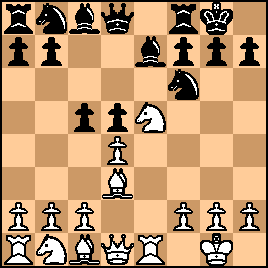
click for larger viewThis was what Pillsbury was looking to play with his 7...0-0 instead of 7...Nc6 10. dxc5
10. c3 was stronger, but at this stage it appeared that Eisenberg was aiming for a draw against his celebrated opponent. 10... Bxc5
11. Nc3 Nc6
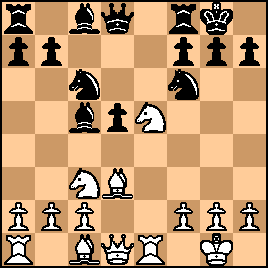
click for larger viewEisenberg had emerged from the opening with a tiny edge. As so often in such positions, the question posed was status/value/weakness of the isolated d-pawn. I doubt the isolated pawn bothered Pillsbury much at this time, since he had dealt with this issue successfully in the past. In this case, the loss of this isolated pawn in the endgame led to Pillsbury's defeat. But much was to transpire in this game before that point, and Pillsbury was to have ample opportunity to avoid loss if not to play for a win. |
|
Oct-02-22
 | | KEG: Post II
12. Bg5
Pseudo-aggression played, as will soon become apparent, with the idea of exchanges and the goal of drawing. But since the game at this point was about even, the text cannot be called a mistake, and given the final result, it wound up working just fine. 12... Be7
The Tournament Book was not happy with this move or with Pillsbury's strategy to this point. And perhaps there were stronger choices (e.g., 12...h6 or 12...Be6 or 12...Nxe5). But Black is hardly all that bad after the text, and besides, Pillsbury was never unhappy about playing endgames (since he nearly always managed to win them). 13. Qf3
Hard to understand this move except as some sort of preparation for mass exchanges. 13. Nf3 or 13. Qe2 or even 13. h3 all seem to make more sense if White were playing to win. 13... Be6
13...h6 looks better.
14. BxN
This minor piece trade helps only Black. Also doubtful was the Tournament Book's suggested 14. Rad1 which allows Black to obtain the better chances after 14...NxN 15. RxN Bg4 16. Qf4 (even worse for White would be 16. Qg3 BxR 17. NxB) 16...BxR 17. NxB Re8 where White at best has decent compensation for the lost exchange). White can retain some edge with 14. Nb5 or avoid trouble with 14. h3. 14... BxB

click for larger viewDespite his isolated d-pawn, Black with his two Bishops was now better. It is astonishing that Pillsbury lost this position against eventual 18th place finisher Eisenberg. 15. Qh5
15. Ng4 was probably better, but even then Eisenberg would have faced an uphill game. 15... h6
Though sneered at by the Tournament Book, best for Black here was clearly 15...g6; e.g., 16. Nxg6 (White's only chance to avoid a strategically lost game is to try this sacrificial line) 16...fxN (Black would have no edge after 16...hxN 17. Bxg6! fxB [unlike what would ensue after 16...fxN, Black now cannot play Qd7 since he would now be mated on h7] 18. Qxg6+ Bg7 19. QxB+ Rf7 20. Nxd5 leaving White with four pawns for the sacrificed piece--this was apparently the line considered by the Tournament Book) 17. Bxg6 Qd7! [this move giving Black the edge following 16...fxN was probably overlooked by the Tournament Book's analysis]. 18. RxB (basically forced) hxB (forced) 19. Qxg6+ Bg7 20. Rd6 Qf7 21. QxQ+ RxQ 22. Rxd5 BxN 23. bxB Re8 and Black, despite White's four pawns for the piece, has much the better endgame given White's shattered Queen-side. After 15...h6, Black's edge had vanished:

click for larger view16. Ng4 BxN (g4)
If instead 16...Bg5 White can sacrifice the exchange for two pawns and get--if anything--the better endgame: 17. RxB! fxR 18. h4 Bf4 19. Qg6 Rf7 (everything else is worse) 20. Qxe6 Qd6 21. QxQ BxQ 22. Nxd5. 17. QxB BxN
18. bxB
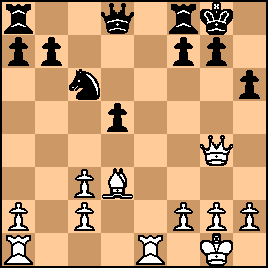
click for larger viewIt is not clear who is better here. Material is even. White has a busted Queen-side. Black has an isolated d-pawn. White's Bishop is better than Black's Knight. I would have expected Pillsbury to win this position against Eisenberg either as White or as Black. But that's not how it turned out! |
|
Oct-03-22
 | | KEG: Post III
18... Qf6
19. Re3
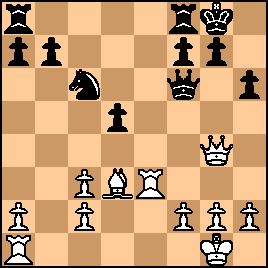
click for larger view19... Rfe8
The Tournament Book claimed that Pillsbury here "[threw] away a probably draw," and suggested 19...Ne5 as best. This is bonkers. There was nothing wrong with the text and it had nothing to do with Pillsbury's eventual defeat. And 19...Ne5 would have allowed White to obtain a small edge with 20. Qd4 NxB 21, QxQ gxQ 22. cxN which leads to a double Rook ending that is probably a theoretical draw but in which White has the better chances because of the grotesque Black pawn structure on the King-side. Meanwhile, Pillsbury should habe been just fine (i.e., have equal chances) with the text. 20. RxR+ RxR
21. Qd7
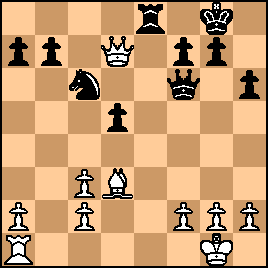
click for larger view21... Kf8
This was better than the Tournament Book's suggested 21...Qe7 which, after 22. Qxd5 Rd8 leaves Black a pawn down after which, despite White's shattered Queen's side, he would still have some work to salvage a draw. 22. Rb1
Eisenberg should just have satisfied himself with 22. Qxb7 Qxc3 leaving approximate equality. The text was not all that bad either, but it did allow Pillsbury some chances to play for at least a small edge (which was all that Pillsbury usually required to press for a win): 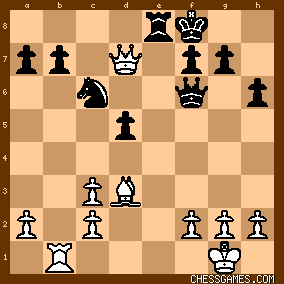
click for larger view22... Qxc3
A doubtful choice by Pillsbury, gobbling up White's most useless pawn while allowing Eisenberg some chances to play for an advantage. Better was 22...b6. Even 22...g6 was better than the text. 23. Rxb7

click for larger view23... Qe1+
24. Bf1 Qe6

click for larger viewSimplest for White here was 25. QxQ RxQ 26. g3 leaving an ending in which White, with the far superior minor piece, should be able to press for winning chances with little chance to lose. But instead Eisenberg played:
25. g3

click for larger view25... QxQ?
Best here is 25...Re7 as suggested on this site by <beatgiant>. Then, after 26. QxQ (forced) fxQ [better than 26...RxQ 27. Rd7] 27. Rb5 with an even ending (and not 27. RxR KxR as given by <beatgiant> giving Black the better ending. If then 27. a3? as suggested by <beatgiant> (White can almost certainly survive with 27. c3) Black has good chances to win with 27...Nd4 or with27...Kd6 as given by <beatgiant>. 26. RxQ
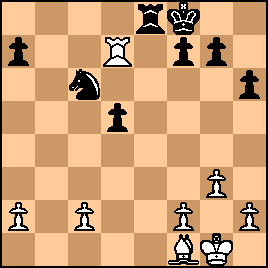
click for larger viewBlack is not lost (the Tournament Book notwithstanding) here, but Pillsbury was still seeking a win, and got into what should have been fatal trouble, was given a chance later on to draw by Eisenberg, and yet again got lost trying to win a seriously inferior but perhaps savable position. I will begin to cover this strange catastrophe for Pillsbury in my next post on this game. |
|
Oct-04-22
 | | KEG: Post IV
26... Rd8
Hardly best. 26...Nd4 or maybe 26...Nb4 or 26...Rc8 would avoid the following finesse by Eisenberg. What would still eventually win a pawn, but the resulting ending would be at best problematic for White to win; e.g., 26...Nb4 27. Rxa7 Nxc2 28. Rd7 Ra8 29. Bg2 Ra5 30. Bxd5 Ke8 31. Rx7 RxB 32. RxN Ra5 (and White has an extra a-pawn but the Black Rook is in front of the pawn and the White Rook in a defensive posture; or (not quite as good but tough to defeat: 26...Nd4 27. Bd3 Rx8 28. Rxd5 Nxc2 29. Ra5 Nb4 30. Be4 Rc4 11. f3 Rc7 27. Rx7
The White Rook has a commanding post:

click for larger view27... Rd6
Playing for complications rather than the likely more testing (for White) 27...Nd4. 28. Bg2
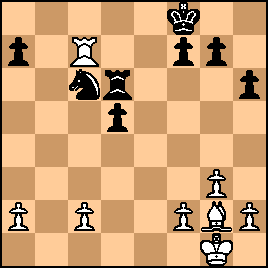
click for larger view28... a5?!
28...Ke8 or 28...a6 would have made Eisenberg's task more difficult. 29. c4!
"Excellently played." (Tournament Book)
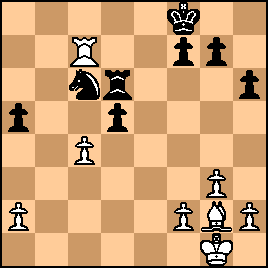
click for larger view29... Nb4?!
Pillsbury seems intent on taking chances to try to win rather than fighting for a draw and then looking to beat Eisenberg in the replay in which Pillsbury would have had White (which would yield under the system employed at Monte Carlo 19023/4th of a point). 30. a3! Na6?!
Still going for broke instead of trying to hang on with 30...Nc6. 31. Rc8+ Ke7
32. Bxd5
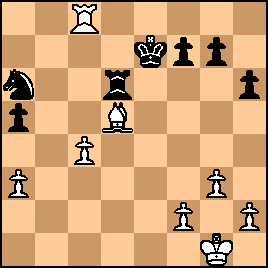
click for larger viewBeginning to look like a simple win for White. But Pillsbury was far from ready to lower his flag. 32... f5
Probably the best try in this lost endgame for Blacdk. 33. Kf1
33. Kg2 would save a tempo (see move 35).
33.... Rb6
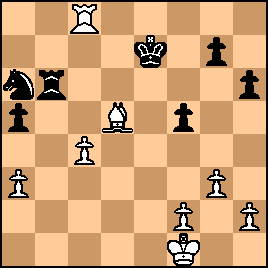
click for larger view34. Ra8
The beginning of a sort of wild goose chase for White. Simpler was to play h4 and Kg2 and grind Black to dust. 34... Kd6
35. Kg2
Probably better to try Rd8+ and then Rg8 or maybe just h4. Suddenly, Pillsbury's chances no longer appeared hopeless: 
click for larger view |
|
Oct-04-22
 | | KEG: Post V
35... Kc5?!
Pillsbury apparently couldn't stomach 35...a4 (probably the best way to play for a draw). The text looks crazy, but it nearly worked!
36. Kf3?
36. Ra7 probably wins for White. The text, by contrast, seems to blow the win, the position now being: 
click for larger viewHere, Pillsbury probably could have held the draw with 36...Kd4! But instead he swung for the bleachers with: 36... g5?!
Now White should win in a walk: 37. Ke3 Rb3+ 38. Kd2 Nc7 39. Rxa5+ But Eisenberg gave Pillsbury one final (admittedly small) chance: 37. g4
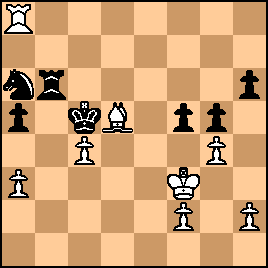
click for larger view37... Rf6?
Now the game is beyond salvage for Black. Like it or not, Pillsbury had to try 37...fxg4+. Now the win was simple for Eisenberg:
38. gxf5 Rxf5+
39. Ke4!
The simplest:
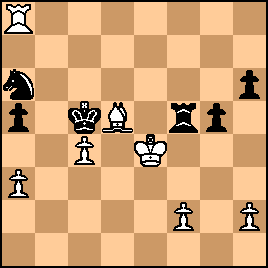
click for larger view39... Rf4+
40. Ke5 Kb6
40...Nc7 would perhaps have made Eisenberg's win a tad more challenging, but the game was over in any case. 41. f3
41. Rh8 also wins easily. After the text, the position was: 
click for larger view41... Nc7
This loses immediately. But nothing would have saved the game for Pillsbury bu thus point. 42. Rb8+
A killer!
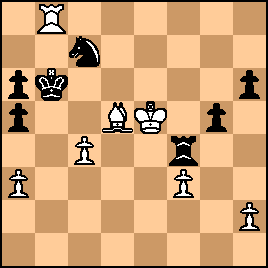
click for larger view42... Kc5
43. Rc8
Ouch!
43... Kb6
44. c5+

click for larger view1-0
With the loss of a piece, even Pillsbury had to call it a day. |
|
| Jan-31-23 | | WilhelmThe2nd: From the chess column of the Odessa newspaper 'Odesskie Novosti' (written by I. Abelson), Feb. 18th, 1902 (Old Style), page 4; translated from the original Russian. (The quotes from Pillsbury and Gunsberg were given in the original English and German, respectively. Abelson gave a Russian translation of Pillsbury's words, which I have omitted, but gave no translation of Gunsberg's words, which I have supplied in square brackets. The phrases that appear between '<...>' were given in italics in the original text.): The game <Eisenberg-Pillsbury> (see 'Od. Nov.' No. 5550, game No. 146) created a sensation among the participants of the tournament and in the chess world. At the end of the game, won, as is known, by Eisenberg, the participants of the tournament began to analyze it, confident that the famous American champion had committed an error. Analysis of the game, however, showed that it was played correctly by both sides. Moreover, some maestros consider this game — <one of the very best played so far in this tournament>. Pillsbury himself stated that his opponent's play was "very, very fine". Gunsberg, having examined the game, noted that "Eisenberg hat total seinen Gegner Überspielt" ["Eisenberg totally outplayed his opponent"] and that it was played by Eisenberg <with the strength of his opponent>. The tournament participants, together with Messrs. Arnous de Rivière and Hoffer, consider "the Odessan Eisenberg" to be a talented chessplayer who lacks practice in tournament play, endurance and so-called tournament routine. If we add to this, that for all that, in addition to winning against Pillsbury and Reggio, he managed to win something else from many of the undoubted prize-winners who he played to a draw (1/4 points from Janowski, Marshall and Teichmann, and 3/4 of a point from Mieses), then we must admit that Mr. Eisenberg was successful enough for his first time. He still has 5 rounds left to play. There will be 21 rounds in total. |
|
|
|
|





































